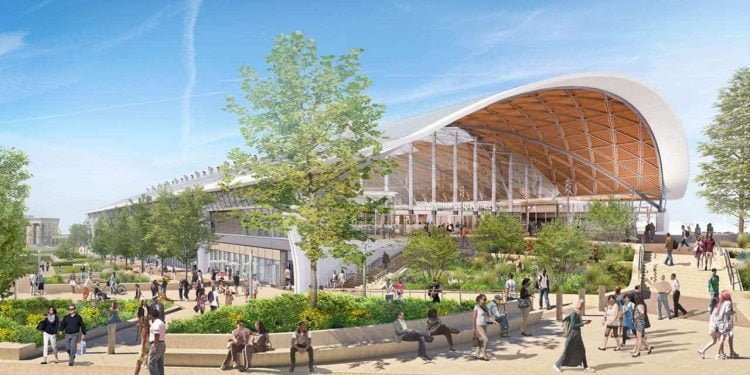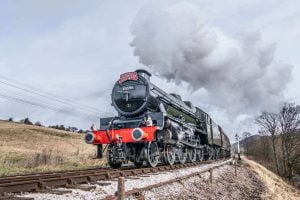Ninety specialist engineers have assembled HS2’s giant tunnel boring machine (TBM), which will begin digging the second bore of the Bromford Tunnel into Birmingham in 2024.
Assembling the machine involved moving its sections of into a twelve-metre deep launch pit. Two six-hundred-tonne cranes lifted the 125-tonne cutterhead into place, for it to be attached to the front of the 125-metre-long machine in the pit bottom.
The first TBM is named ‘Mary Ann’ after Mary Ann Evans, the real name of Nuneaton-born Victorian writer George Eliot. In August, it began digging the first bore from the east portal site near Water Orton. Since then, it has built more than five hundred tunnel rings, which make up 0.6 miles of the three-and-a half-mile tunnel between North Warwickshire and Washwood Heath in Birmingham.
HS2 will announce the name of the second TBM before it launches in Spring 2024. it expects ‘Mary Ann’ to break through at the end of 2024, and the second TBM to complete its work in mid-2025.
The two machines will excavate and remove 1.87 million tonnes of material. The material will be sifted at the slurry treatment plant at the site and will be reused at Delta Junction, a site nearby where HS2 is building a complex network of nine viaducts.
Most of the components of the second TBM, including its gantries and the centre part of its cutterhead, were previously part of TBM ‘Dorothy’, which excavated the one-mile twin-bore Long Itchington Wood Tunnel in Warwickshire earlier in 2023.
After Dorothy was disassembled, its sections were moved to the Bromford Tunnel portal site near Water Orton.

The Bromford Tunnel is 8.62 metres in diameter, smaller than the ten-metre-diameter Long Itchington Wood Tunnel. This is because trains will travel more slowly on the approach into Birmingham Curzon Street station. The TBM therefore needed a new outer part cutterhead and a new shield, which Herrenknecht manufactured in Germany.
Around 450 people working for HS2’s contractor Balfour Beatty VINCI (BBV) are involved in delivering the Bromford Tunnel programme. The TBM will be operated night and day by a specialist tunnelling team, which includes apprentices working for BBV’s sub-contractor Tunnelcraft. Each bore will take around sixteen months.
The Bromford Tunnel programme als involves designers from Balfour Beatty VINCI’s Design Joint Venture, which is made up of Mott MacDonald and SYSTRA (MMSDJV).
The twin-bore tunnel will be made up of a total of 41,594 concrete segments, creating 5,942 rings, each weighing forty-nine tonnes.
The segments are being produced at Balfour Beatty VINCI’s pre-cast factory at Avonmouth near Bristol. In the concrete mix used at the factory 40% of the cement is replaced with Ground Granulated Blast-furnace Slag (GGBS) which has a much lower carbon footprint than traditional cement. 3D scanning is used in the production process of the segments to guarantee accuracy.
HS2’s Senior Project Manager Catherine Loveridge said: “With the first TBM ‘Mary Ann’ well on her way building the tunnel to take high speed trains into central Birmingham’s Curzon Street Station, it’s fantastic to see the second TBM assembled and being prepared to start digging.
“We’re now at peak construction, with over 9,750 people working on HS2 in the West Midlands and around 450 people working on this site, including many from the local area. Launching the second TBM next year means there will be more exciting jobs up for grabs for local people.”
Jules Arlaud, Tunnelling Director for Balfour Beatty VINCI said, “Completing the assembly of the second tunnel boring machine is another major achievement for the team working on HS2’s Bromford Tunnel – a complex section of the new high-speed railway.
“Getting to this stage has required a huge amount of planning and preparation, including the disassembly and transportation of ‘Dorothy’ parts from Warwickshire, which forms the majority of the second TBM.
“Over the next few months, the team will be busy testing, checking and carrying out the final preparations, to make sure the machine is ready to start digging in spring next year.”
Rosa Diez, Tunnels Discipline Lead for MMSDJV, said, “Seeing the second TBM in position, ready to start, is a proud moment for our tunnelling team. We have learnt so much from the excavation of the Long Itchington Tunnel by our ‘Dorothy’ TBM, which has helped get ‘Mary Ann’ well on her way through the Mercia Mudstone in the Bromford Tunnel. The learning will continue for this second TBM, which once named and launched next year, will also become part of our family”.






Responses